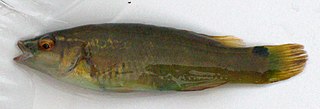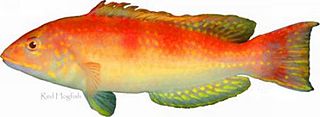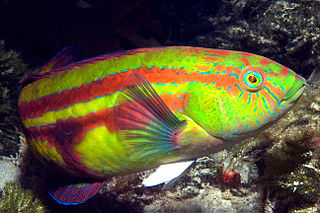
The wrasses are a family, Labridae, of marine ray-finned fish, many of which are brightly colored. The family is large and diverse, with over 600 species in 81 genera, which are divided into nine subgroups or tribes. They are typically small, most of them less than 20 cm (7.9 in) long, although the largest, the humphead wrasse, can measure up to 2.5 m (8.2 ft). They are efficient carnivores, feeding on a wide range of small invertebrates. Many smaller wrasses follow the feeding trails of larger fish, picking up invertebrates disturbed by their passing. Juveniles of some representatives of the genera Bodianus, Epibulus, Cirrhilabrus, Oxycheilinus, and Paracheilinus hide among the tentacles of the free-living mushroom corals and Heliofungia actiniformis.

Anampses is a genus of wrasses native to the Indian and Pacific Oceans.

Pseudojuloides is a genus of wrasses native to the Indian and Pacific Oceans.

Pseudolabrus is a genus of wrasses native to the eastern Indian Ocean and the Pacific Ocean.

Thalassoma is a genus of wrasses native to the Atlantic, Indian and Pacific Oceans. Many species occasionally make their way into the aquarium trade.

Cirrhilabrus, the fairy wrasses, is a genus of fish in the family Labridae native to coral reefs and nearby habitats in the Indo-Pacific region. They are brightly colored and do not surpass 16 cm (6.3 in) in length. Males are larger and more colorful than females. They are commonly kept in aquaria.

Halichoeres are a genus of wrasses found in the Atlantic, Indian and Pacific Oceans.

The goldsinny wrasse is a species of ray-finned fish, a wrasse from the family Labridae which is native to the eastern Atlantic Ocean and associated seas. This species is the only known member of its genus.

Pseudocheilinus is a genus of wrasses native to the Indian and Pacific Oceans.

The slingjaw wrasse is a species of wrasse from the family Labridae which is native to the tropical waters of the Indo-Pacific where it occurs around coral reefs. This species is of minor importance to local commercial fisheries and can be found in the aquarium trade. Relatively mundane at first glance, this fish is notable for its highly protrusible jaws.

The surge wrasse, also known as the green-blocked wrasse, purple wrasse or red and green wrasse, is a species of wrasse native to the southeast Atlantic Ocean through the Indian and Pacific Oceans, where it inhabits reefs and rocky coastlines in areas of heavy wave action at depths from the surface to 10 m (33 ft). This species is of minor importance to local commercial fisheries, is popular as a game fish, and can be found in the aquarium trade.

Symphodus is a genus of wrasses native to the eastern Atlantic Ocean and the Mediterranean Sea.

The slender grouper is a species of marine ray-finned fish, a grouper from the subfamily Epinephelinae which is part of the family Serranidae, which also includes the anthias and sea basses. It is the only species in the genus Anyperodon. It is found in the Indo-Pacific region.

Decodon is a genus of wrasses found in the western Atlantic Ocean, the western Indian Ocean and the Pacific Ocean.

Hologymnosus is a genus of wrasses native to the Indian Ocean and the western Pacific Ocean.

The tubelip wrasse is a species of wrasse native to the Indian Ocean and the western Pacific Ocean. This species occurs in lagoons and on coral reefs at depths from 0 to 20 m. This species grows to 17.5 cm (6.9 in) in total length. It is of minor importance to local commercial fisheries and can be found in the aquarium trade. This species is the only known member of its genus.

The chiseltooth wrasse is a species of marine ray-finned fish, a wrasse from the family Labridae. It is native to the Indian Ocean and the western Pacific Ocean. It is an inhabitant of coral reefs and can be found at depths from 3 to 60 m, though rarely deeper than 40 m (130 ft). This species grows to 30 cm (12 in) in total length. It is of minor importance to local commercial fisheries and can be found in the aquarium trade. P. moluccanus is the only known member of its genus.

Latent sling-jaw wrasse is a species of ray-finned fish from the wrasse Family Labridae which is associated with reefs in the south-western Pacific Ocean.

Pictilabrus laticlavius, the patrician wrasse, the senator wrasse, the green parrotfish or the purplebanded wrasse is a species of marine ray-finned fish from the family Labridae, the wrasses. It is found in the eastern Indian Ocean and the south western Pacific Oceans off the temperate coasts of southern Australia.

Cirrhilabrus adornatus is a species of the labrid fish genus Cirrhilabrus and is also known as the red-fin fairy wrasse or Debelius fairy wrasse. They are found in the Eastern Indian Ocean which is known only from Indonesia over a rubble bottom of 1212m. Male Cirrhilabrus adornatus have two large triangular bright red blotches on the body which are white to pale pink. Female with a black spot three-fourths orbit diameter posteriorly on side of caudal peduncle and shading to white ventrally on head and abdomen. They are small species with a height of 63.4 mm SL, body depth 2.9-3.2 in SL, and head length 2.75-3.05 in SL. Cirrhilabrus adornatus is the combination of 45–47 dorsal-fin rays, 28–30 anal fin rays, 50–52 total vertebrae, 51–54 lateral line scales, 8–12 cheek scales, two large scales on each side of the lower jaw undersurface.





















